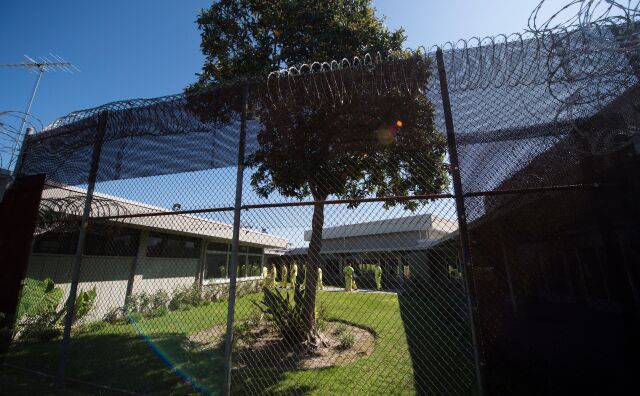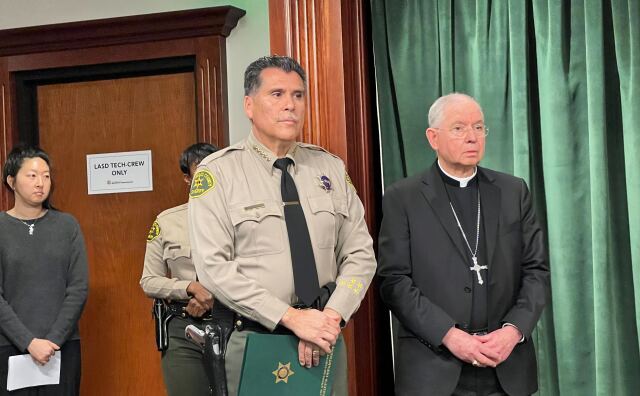UCLA Researchers Say More Than Half of 'Natural' LA Jail Deaths Studied Show Evidence Of Physical Harm

UCLA researchers analyzed the autopsies of people who died in L.A. County jails over 10 years, and found that more than half of deaths classified as “natural” had evidence of physical harm on the bodies.
The researchers with UCLA’s Carceral Ecologies Lab and the BioCritical Studies Lab looked at 59 autopsies out of 292 jail deaths between 2009 and 2019.
UCLA associate professor Terence Keel said at a media briefing on Wednesday that more than half of the 26 people officially classified as dying from issues like cardiac disease, respiratory illness, or even flu, “have evidence of hematomas, bone fractures, and lacerations,” he said.
“If we think about these deaths, and we think about the end of the life course, it seemed to us that these forms of physical violence should be thought through as factors that contribute to the actual death, and not merely described as a natural death itself,” Keel said.
-
Introducing a new series: LAist City Treks
-
Why you won't find the best sunscreens here
-
New video shows alleged assault
The average age of individuals classified as dying of natural causes was around 40 years of age, the researchers said. The average life expectancy of the average U.S adult was nearly 79 years.
“This raises the question, to what degree are these actually natural deaths,” Keel said.
UCLA also found Black people’s deaths were disproportionately classified as natural compared to other races.
More than 75% of the jail deaths analyzed by UCLA occurred before the person stood trial.
“In the jail context, it's a culture of violence. It's a culture of racism. It's a culture of lack of accountability," Keel said.
Autopsy Security Holds
Keel said they couldn’t get a complete picture of what happened as they only received 59 out of 292 autopsies of the deaths in the ten year period.
He said the others were held back under security holds placed by the L.A. County Sheriff’s Department.
“California autopsies and coroner's reports are public documents,” Keel said. “Our ability to do this study was compromised by an inability to access all the records at the time that we began this study.”
In a statement responding to the report, the L.A. County Medical-Examiner Coroner’s Office said that the UCLA report contains several “false statements.”
The office said there were currently no security holds on in-custody deaths.
UCLA researchers said the grassroots organization Dignity and Power Now requested the autopsies through a public records request in 2019, and that the team had not studied autopsies made available after that request.
The coroner’s office also said that 210 autopsy reports were mailed to Keel’s office. Keel told LAist that those reports were for a separate and unrelated research project related to deaths on L.A. County streets — not in-custody deaths.
“They’re talking about cases that we didn’t discuss,” said Keel.
The L.A. County Department of Health Services, which employs correctional health workers who take care of incarcerated patients, said they were “not responsible for conducting or providing oversight of the autopsies and investigations of deaths that take place in the jails.”
A spokesperson for the L.A. County CEO’s office referred a request for comment to the coroner’s office.
About Those Deaths

More than 75% of the jail deaths analyzed by UCLA occurred before the person stood trial.
“In the jail context, it's a culture of violence. It's a culture of racism. It's a culture of lack of accountability, Keel said.
“None of this is surprising,” said Justin Feldman, a research fellow at the Harvard FXB Center for Health and Human Rights who studies police killings and reviewed the UCLA study findings and methodology.
Feldman has called for independent medical examiners and coroners in the past, and said that UCLA’s findings were consistent with nationwide trends. “It is alarming, and it should spur people to action,” he told LAist.
“Autopsies can be ambiguous. Where there is room for interpretation, there is room for various kinds of bias.”
Conditions At The Jails
Earlier this year, LAist reported on conditions at the L.A. County jails, where more than 12,000 people are incarcerated on any given day.
LAist’s reporting found that sheriff’s deputies regularly ignored COVID-19 safety protocols and have allegedly discouraged detainees from getting vaccinated.
In May, LAist published an investigation into jail conditions from the perspective of correctional health workers. Current and former medical staff describe a working environment that is dysfunctional, abusive, and detrimental to providing health care.
Jail deaths in L.A. County have steadily increased since 2016. At the same time, data from the sheriff's department obtained by Reuters showed that security holds on autopsies also increased.
“Over 90% of the deaths that occurred in 2019 remained under security hold the following year,” said UCLA assistant professor Nicholas Shapiro.

Shapiro also said none of the reviewed autopsies appear to have followed national recommendations for consulting jail medical and mental health records when investigating deaths in custody.
Best practices set by the National Association of Medical Examiners recommend that both the forensic investigators who visit the scene of a jail death as well as the deputy medical examiner consult both jail records and paramedic medical records of the decedent.
That did not happen in any of the cases reviewed by UCLA, Shapiro said. And that leads to a “word of mouth” situation, he said, where the sheriff’s department is the primary testimony.
“With these kinds of empirical blinders, it is easy to see how unnatural deaths can become naturalized, or steered by the sheriff's department towards being deemed undetermined,” Shapiro said.
When asked directly about whether there may be an issue with investigators ignoring medical records compiled by correctional health staff, the department of health services said that medical records are a “key resource… that should be used to gain a deeper understanding of an individual’s medical conditions and overall physical wellbeing.”
Law Enforcement Officials At Autopsies
Law enforcement were also present at nearly 90% of the autopsies reviewed by UCLA researchers.
Policing experts say the presence of law enforcement at autopsies and the reliance on law enforcement as testimony to a decedent’s cause of death is concerning.
“Those are conflicts of interest,” said Harvard fellow Justin Feldman. “[Law enforcement] can not only place pressure on the death investigators, but provide a particular version of events that makes them look good.”
“The allegation that DMEC and its personnel are unduly influenced by the Los Angeles County Sheriff’s Department is false,” the coroner’s office said in a statement.
In a statement, the sheriff’s department said they “do not make determinations on manner and cause of death,” but, “conduct extensive internal inquiries into every death which happens within one of its jail facilities.”
They noted that as part of a 2015 federal settlement agreement related to conditions inside the jails, “the United States Department of Justice participates in these reviews along with representatives from the Office of Inspector General, the Office of the County Counsel, and medical personnel from Correctional Health Services.”
Why Some Families Pay For Independent Autopsies
Yet some family members of people who died in the jails do not trust that the deaths are being investigated fairly. Some pay for independent autopsies, as was the case for the family of Andres Guardado, the 18-year-old shot and killed by a sheriff’s deputy in 2020.
That independent autopsy found that Guardado was shot five times in the back.
Days later, the county lifted a security hold placed by the sheriff’s department on Guardado’s official county autopsy in defiance of the department’s wishes.

“It’s just sad that my family, and not only my family, but so many other families are suffering today,” said Helen Jones, whose son John Horton died while in solitary confinement at Men’s Central Jail in 2009.
The county initially claimed Horton’s death was a suicide, but later ruled it as undetermined; Jones attests that her son was beaten to death by deputies involved with the 3000 Boys, a deputy gang that allegedly operates within the jail.
Jones said she has photos of his battered corpse, and a coroner’s report found he’d also suffered injuries to his liver and his kidney.
Jones directed her anger and frustration squarely at the coroner’s office.
“After 13 years, y’all are still covering up deaths… and helping the sheriff’s department get away with murder,” she said.
-
In December 2020, Sadie and Eddie Martinez were falsely accused of attempted kidnapping by a white woman who had been shopping at a Michaels craft store at the same time as them. This is the story of Sadie's fight to clear their names and bring her accuser to justice.
-
An Orange County public defender has tallied 57 tainted criminal cases stemming from the county's informant scandal. New revelations of alleged misconduct could affect dozens more.
-
Ryan Clinkunbroomer was found in his patrol car near the Palmdale station. He was a third-generation sheriff's deputy.
-
L.A. County prosecutors say David Bloom scammed nine people out of nearly $250,000. Bloom, a twice-convicted con man known in the ‘80s as the “Wall Street Whiz Kid,” allegedly trolled for victims in a Hollywood apartment building and local bars.
-
Edward Bronstein died in March 2020 while officers were forcibly taking a blood sample after his detention.
-









